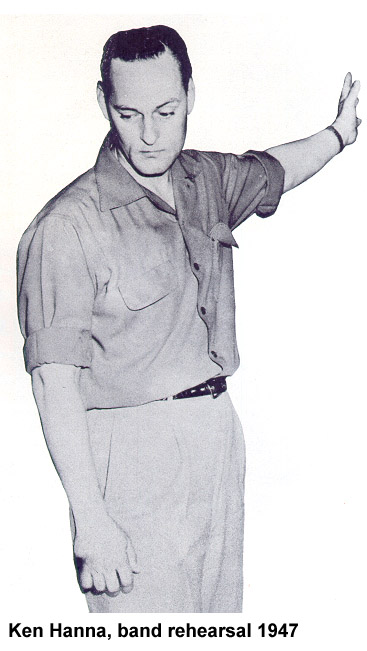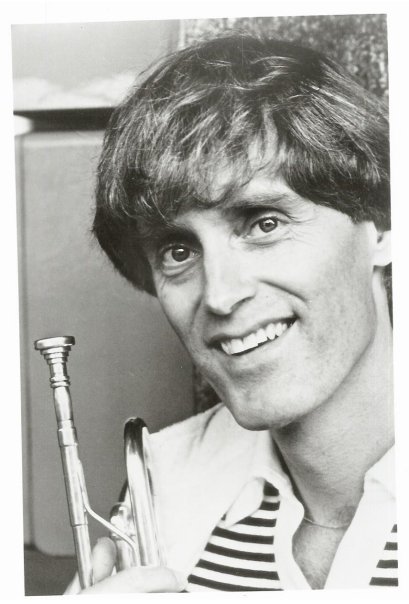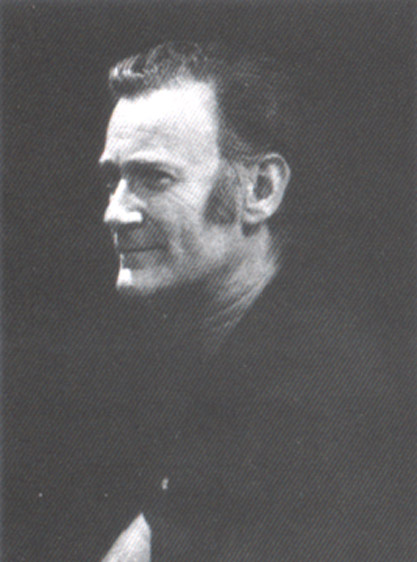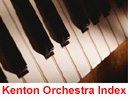|
Henry J. (Hank) Levy
was born in Baltimore on September 27, 1927. Like any other
child of that era, he was raised with the opportunity to hear a variety of
music, ranging from favorite Sousa marches to the latest Tommy Dorsey hits
broadcast live on coast-to-coast radio. Surrounded by the sounds of the
big bands. Hank's interest in that form developed at an early age. These
early listening experiences laid the foundation for what would become his
life's work, the composition and teaching of a specifically American
musical genre, jazz.
He
began
taking saxophone lessons while in grade school. Even as a youngster,
he wanted to write his own music and by age twelve had completed the
first of many compositions. While still in high school, he was asked to
join Ken Hanna's band, filling a void left by the many Baltimore
musicians called to duty in the armed services during World War II.
Ken, a former trumpet player and arranger for Stan Kenton. introduced
Hank to the big band scene, which included Stan Kenton's recordings and
charts. Reminiscing, Hank recalls "what a kick it was, getting Kenton
manuscripts to work on."
After
graduation. Hank served as a musician in the U.S.. Navy from 1945-1948.
He returned home and worked with his father and uncle in the family
business, the Independent Beef Company, dealing in custom meats,
fruits, vegetables, and fine wines. While helping out at the store,
Hank often worked on his compositions, sometimes to the impatience of
customers. "I used to tell my father, 'Just let me finish one more
score page.'" He attended Peabody Conservatory for a year, but his
talent and connections led him in another direction that would be a
stepping stone to his future.
 In
January
of 1953, Hank decided to visit Ken Hanna, who had relocated to
California. Hank recalls the experience: "Ken was still writing for the
Kenton band and had asked me if I had any charts I could bring with me.
He told me that the Kenton hand was at the Palladium and would he
rehearsing there. We would take the charts over and see if Stan would
run them down for me. Stan was very gracious and gave me some time in
front of the band, he said the charts were OK, but not right for his
band. Stan said, 'You can't really write for this band yet. You'd have
to spend some time with the band to know the guys and their
personalities so that you could write more personally for the band.' He
said that he saw some things he thought had promise and to keep on writing. In
January
of 1953, Hank decided to visit Ken Hanna, who had relocated to
California. Hank recalls the experience: "Ken was still writing for the
Kenton band and had asked me if I had any charts I could bring with me.
He told me that the Kenton hand was at the Palladium and would he
rehearsing there. We would take the charts over and see if Stan would
run them down for me. Stan was very gracious and gave me some time in
front of the band, he said the charts were OK, but not right for his
band. Stan said, 'You can't really write for this band yet. You'd have
to spend some time with the band to know the guys and their
personalities so that you could write more personally for the band.' He
said that he saw some things he thought had promise and to keep on writing.
"The
band
took a break and then Bob Gioga went to talk to Stan and gave his
notice. .Stan looked at Ken Hanna and said, 'Where am I gonna find a
baritone (sax) player?' Ken turned around and pointed at me! Now when a
guy like Ken Hanna recommends somebody, Stan will act on it. He came
back right away and offered me the job. I told Stan that I really
wanted the job, but had some reservations. 'I want you to be happy with
what I'm doing as a player. Let me play first and then if you like it,
OK.' He said, 'OK. sit in the band.' I said that I didn't have a horn
and he said, 'You can use Gioga's.
"So,
I've got about five minutes to become a bari player,
I'm running through some things in a closet, trying to figure out
Bob
Gioga's setup, and I hear them getting ready to start. I'm scared to
death—I mean, look who's on that stage: Lee Konitz, Bill Holman,
Ritchie Kamuca, Frank Rosolino, George Roberts, Buddy Childers. Conti
Candoli, Maynard Ferguson . . . and me! I tell you, I was about to soil my
Pampers! Then a guy walks up to a microphone and says, 'NBC presents
live, from coast to coast, A Concert
In Minature Jazz, featuring the Stan Kenton Orchestra.'
Every Tuesday they used to
broadcast these things. I looked over to where Bob Gioga was sitting
and offered his horn back; he just waived his hand, as if to say, 'No
thank-you.' Anyway, I survived, and Stan said, "Let's go.' I called
home and said, 'I'm going with the Kenton band, and—by the way—could
you send me enough money for a baritone sax?'"
After
a six-month
tenure with the band. Hank returned home to the family business. It was
during this time that he became more determined to develop his
compositional talents, and began to focus his efforts in that
direction. In 1958, he got his first commission when Sal Salvador, a
friend from the Kenton band, hired him to write for Sal's all brass big
band in New York. Hank contributed many charts over the next three
years and experienced the thrill of having his music recorded lor the
first time.
Around this time, Dave Bruheck's album Time Out featured odd-meter
compositions. Then, the 1962 Grammy Award winning album, Adventures In Time: A Concerto for Jazz Orchestra,
was released by the Stan Kenton Orchestra. This album, written and
arranged by Johnny Richards, acted as a catalyst for Hank's experiments
in odd-meter music. At the same time, Hank was studying Bartok quartets
and Stravinsky's works.
 To try his forays into odd meters. Hank
organized his own rehearsal band. His lead trumpet player, Glen
Stuart, met trumpeter Don Ellis on a summer time tour. At the time, Don
was studying Indian tabla playing, a rhythmically complex musical form.
Later, when Don formed his own band in California, he hired Glen to
play lead trumpet, Glen called Hank and said. "You and Don are
experimenting along the same lines. Why don't you send us some charts?"
As a result, Hank started writing for Don Ellis' band in 1965 and
continued for the next ten years. To try his forays into odd meters. Hank
organized his own rehearsal band. His lead trumpet player, Glen
Stuart, met trumpeter Don Ellis on a summer time tour. At the time, Don
was studying Indian tabla playing, a rhythmically complex musical form.
Later, when Don formed his own band in California, he hired Glen to
play lead trumpet, Glen called Hank and said. "You and Don are
experimenting along the same lines. Why don't you send us some charts?"
As a result, Hank started writing for Don Ellis' band in 1965 and
continued for the next ten years.
During this period, Towson State College had organized a ten or eleven
piece stage band. Hank was hired to write, conduct, and provide a
direction for the jazz. program, as well as to build a jazz library.
Since he had not finished a college degree, the faculty listed him as a
Visiting Guest Lecturer with the stipulation that he finish a music
degree at the college. While keeping up with teaching and composing, he
took classes the next two years—often sitting beside his own students!
Stan Kenton heard Hank's Towson State College ensemble performing the
music Hank wrote for Don Ellis' band at the Intercollegiate Jazz
Festival in Quinnipacc, Connecticut. Stan. a fan of Don Ellis, hired
Hank to write for the Kenton ensemble. They continued to collaborate
until Stan's death in 1979. Hank frequently served as guest conductor
for live performances and recordings of his own music, and as an
instructor and host for the Kenton clinics, which were held nationwide.
The Levy name began to attract students from around the country to
Towson State, and the growing program attracted the attention of the
music department chairman. Hank was summoned to the chairman's office
where he was told, "Mr. Levy, we do not want to be known as a jazz
college.' " Hank replied, "Sir, I am afraid you are too late."
Hank retired from Towson State University in 1991. but continued to
write by commission. Many of his older works are available through a
variety of publishing companies. He directed the Towson State Alumni
Jazz Ensemble and was also active with several rehearsal bands in the
Baltimore area. On February 25, 1997, Hank Levy was appointed Professor
Emeritus at Towson State, continuing his long-standing and esteemed
relationship with the school. He and his music continue to be an
inspiration to students and professional musicians alike.
Hank Levy died of congestive heart failure on September 18, 2001 in
Baltimore, Maryland
About Hank Levy Alumni
Band
The Hank Levy Alumni Band is
dedicated to performing the music of Hank Levy.
Most of the band members are
professional musicians who studied and played with
Hank. Hank Levy was best known
for his work as a jazz composer and arranger,
notably with bands led by Don
Ellis and Stan Kenton, and later for his work as a
jazz educator. He was
interested in giving jazz what he called "a kick in the rear
end" by using odd meters like
5/4, 7/4, 9/4 and 13/8, and by employing unusual
harmonies and voicings. His
music was considered difficult to master but rewarding
to play by the various bands
with which he was associated, including his own groups.
|


